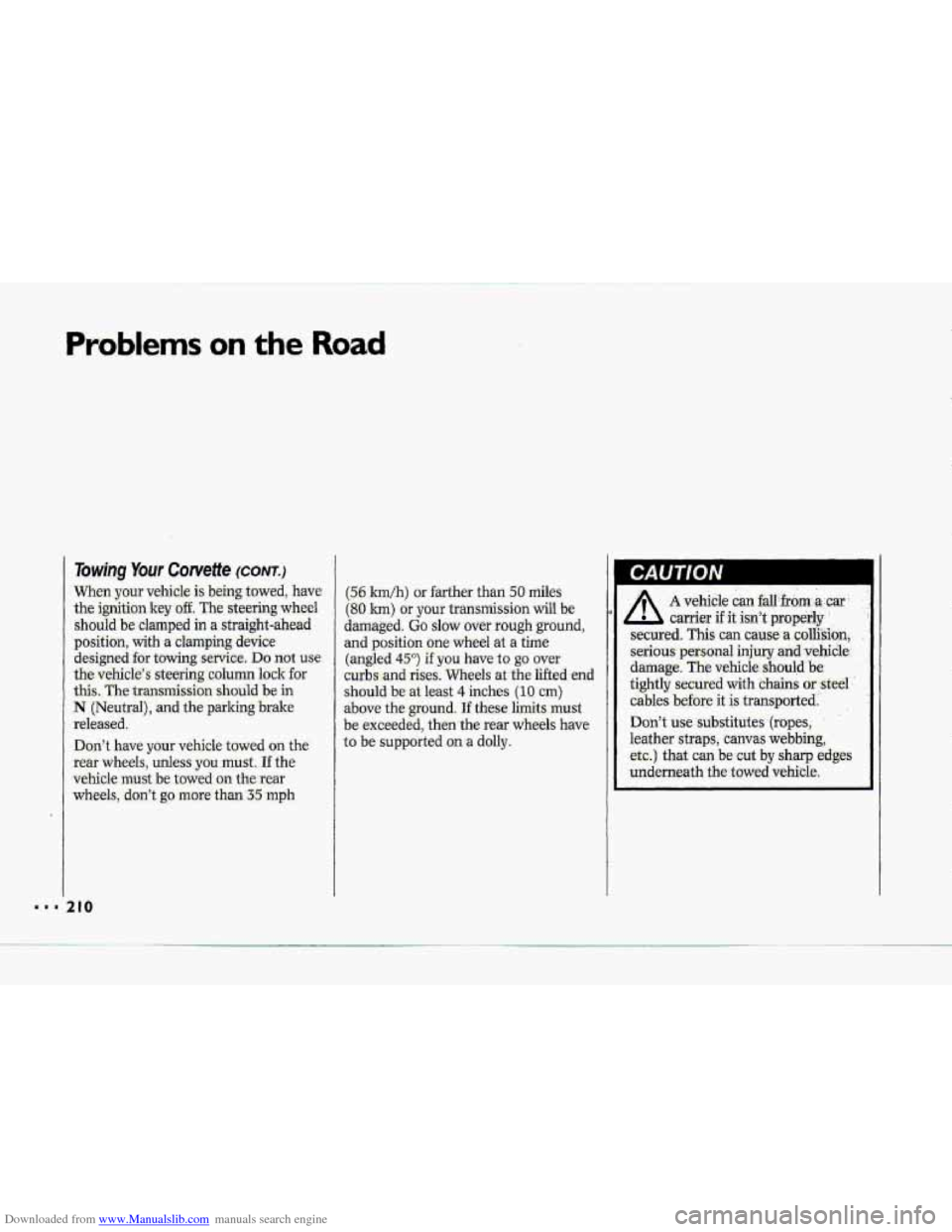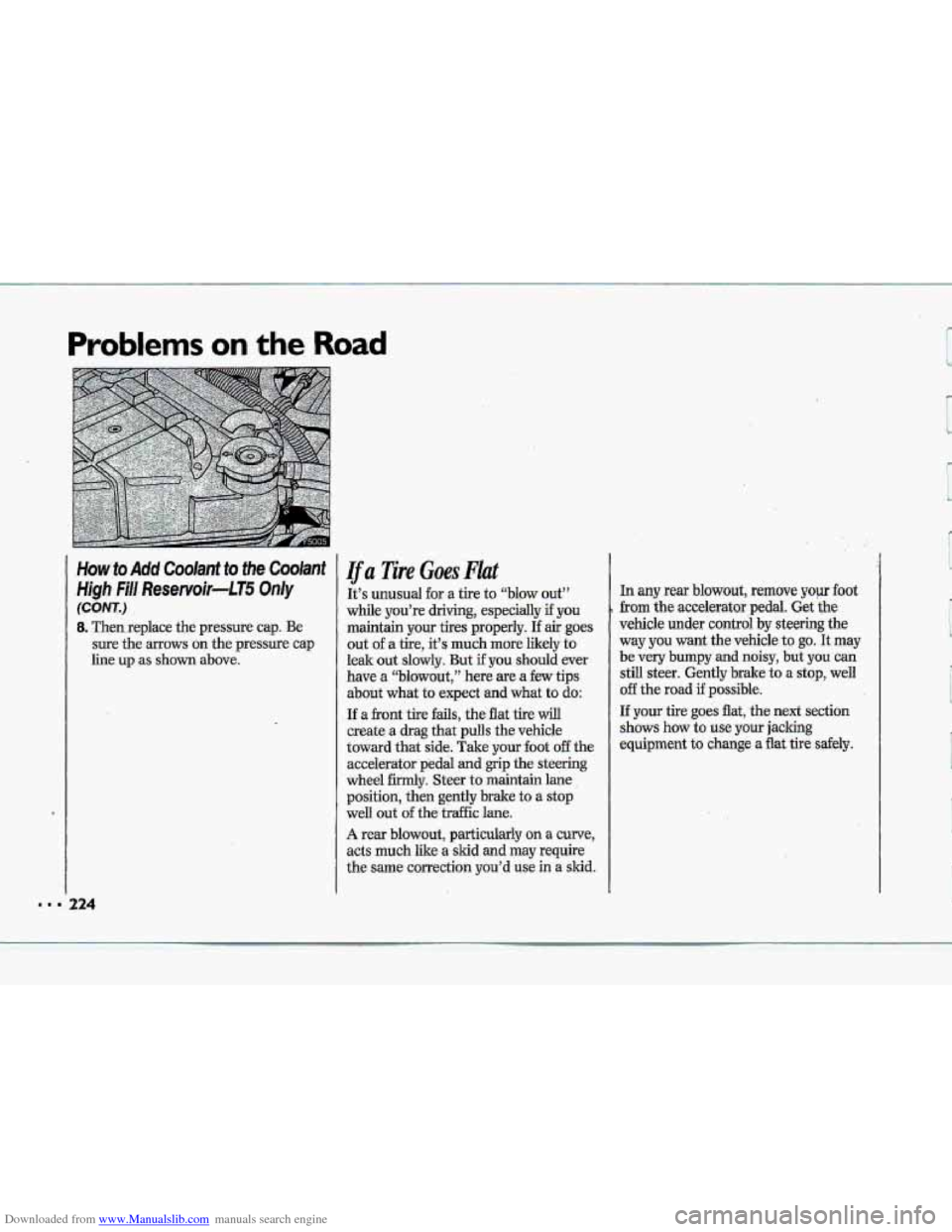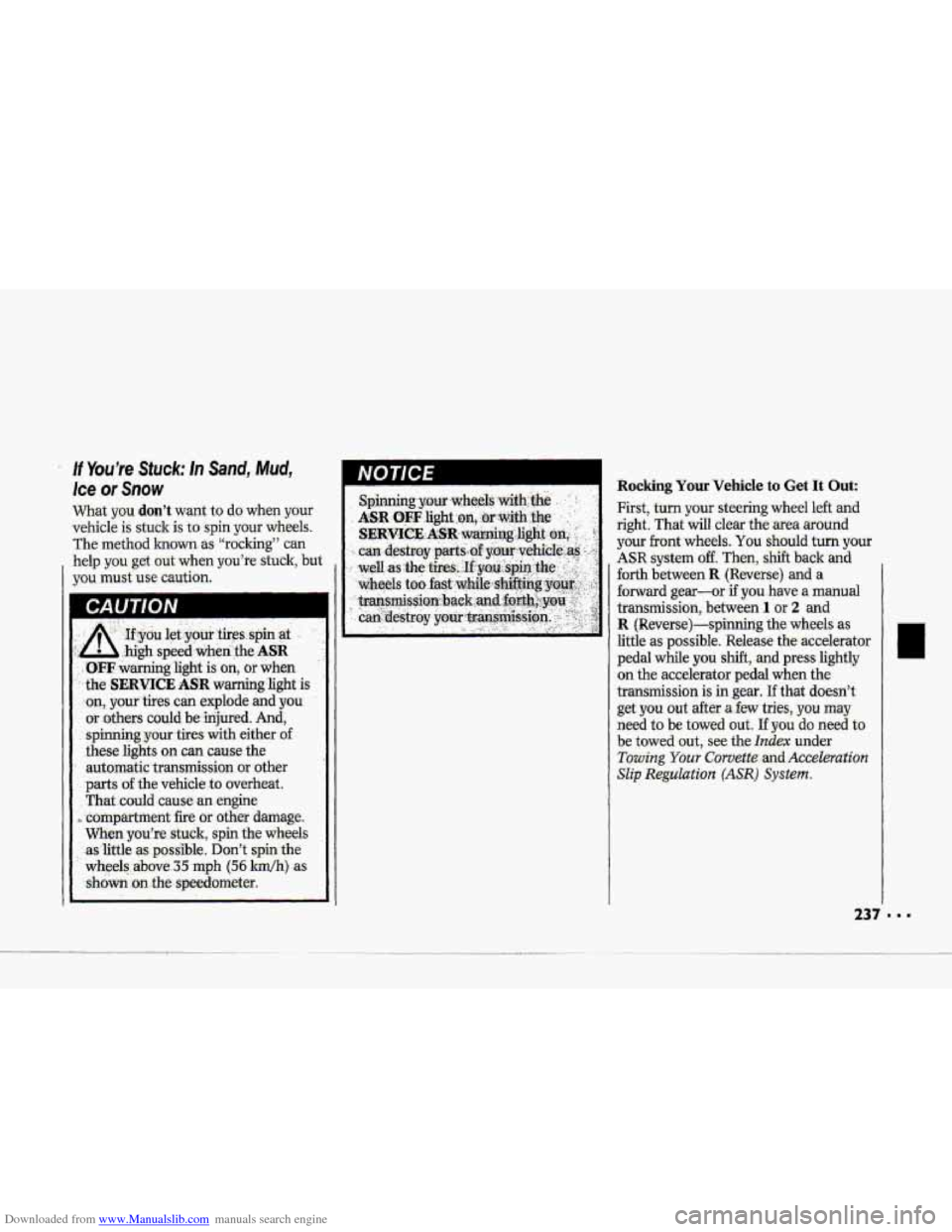Page 200 of 370

Downloaded from www.Manualslib.com manuals search engine m-4.
Driving on Snow or Ice
Most of the time, those ,places where
y6ur tires meet the road pr:obably
have
good traction.
However,
if there is mow or ice
betwe.en
you^ tires and the road, you
can have a very slippery Situati-on.
You’ll have alot lcss traction Crr
“@p”and -will need t.Cbe very careful.
What’s the wors;t- time for this? “Wet
ice;” Very cold
mow or ice can be slick
and hard to drive on. But-wet. ice can be
even more trouble .because it-may offer
the least
traction .o% all. You c.an iet wet
ice-when -it% about freezing (WF, PC)
2nd heezing pain begins- to fall. Try to
avoid driving an wet ice until salt, and
sand crews ean get there.
Allow greaterfollowing distafice on
any slippery road.
Watch for slippery spots. The road
might be fine until you hit a- spot
that% covered with ke. On an
othehvise dear roadyice patches may
appear in shaded areas- whefe. the sun
can’t reach: around clumps crf trees,
behind buildings, or under bridges.
Sometimes-
the &dace of. a curve or
an overpass may remain icy’when. the
surrounding roads are dear. If you see
a patch of ic.e ahead of you, brake
befgre you are on it. Try not to, brakc
while you?e:actu.al€y on the ice, and.
avoid
sudden steering maneuvers,
Page 211 of 370

Downloaded from www.Manualslib.com manuals search engine Towhg Your Corvette (CONT.)
When your vehicle is being towed, have
the ignition key
off. The steering wheel
should-be.
clamp,ed in a straight-ahead
position, with a clamping device
designed fur towing s-ervice. DO not use
the vehicle's stewing column iock for
this. The transmission shoLild be in
N [Neutral), and the.parlepg brake
released.
Don't have your vehicle tqwed on the
rear wheels,. unless you must. If the
vehicle
must. be t0we.d on the rear
wheels, dan't go more than 3mph
I
(56 km/h) or farther than 50 miles
(80.h) or your transmission will be
-damaged. Go slow over rough ground,
and position one wheel at a time
(angled 450j if you have- to go over
eurbs.and
rises. .Wheels &the lifted end
should be-
at. least 4 inches (10 cm)
above the ground. If these limits must
be
exceeded, then the rear wheels have
to be supported .on-a dolly.
I
.,
A
A vehicle can faH~~~m~a:c~
carrier if ,it isn't propgilp '
secured., This can cause a.colii$ion,
serious. pelrsonal injury .and:.vehicle.
damage.
The vehicle..shou[d be
t-ightly secured with chains or--sted -'
cables before it is transported-'
Don't use substitutes '(ropes,
leather straps, canvas webbing,
etc:.) that- can be cut by sharp edges
underneath the t.owed vehicle,
Page 225 of 370

Downloaded from www.Manualslib.com manuals search engine Problems on the Road
lJu Tire Goes Flat
It’s unusual for a tire to “blow out”
while you’re driving, especially if-you
maintain
your tires properly. If air goes
out of a tire, it’s much more likely to
leak out
slowly. But if you should ever
have a “blowout,” here are a few tips-
about what to expect
and what to do:
If a front tire fails, the flat tire will
create a drag that pulls the vehicle
toward that side. Take yuur foot 08 the
accelerator pedal
and grip the steering
wheel firmly. Steer to maintain lane
p-osition, then gently brake to -a stop
well out of the. traffic lam.
A rear blowout, particularly on a curve,
acts much like a skid and may require
the
same corre&ion you’d use in a skid.
h any rear bhwout, remove yop foot
from the accelerator pedal. Get the
vehicle under control by steering the
way you want the vehicbto go. It may
be very bumpy and noisy, hut you can
still steer. Gently brake to B stop, well
off’ the road if posiible.
If your tire go& flat, the next section
shows how to use your jacking
equipment to change a flat tire sdely.
e
Page 238 of 370

Downloaded from www.Manualslib.com manuals search engine c
c-
If You’re Stuck: In Sand, Mud,
Ice or Snow
What you don’t want to do when your
vehicle is stuck is to spin your wheels.
The method
known as “rocking” can
rou must use caution. I help you get out when you’re stuck, but
CAUT/UN I
A: If :you let.your :tires. spin -at
high speed.when the ASR
, . ‘OFE warning light is on, or when
“the SERVICE ASR warning light is
‘on, your tires can explode and you
or others could be injured. And,
spinning your tires with either of
these lights on can cause the
automatic transmission
or other
parts of the vehicle to overheat.
That could cause an engine
compartment fire or other damage.
When you’re stuck, spin the wheels
as little as possible. Don’t spin the
wheels above 35 mph (56 M) as
shown on the speedometer.
Rocking Your Vehicle to Get It Out:
First, turn your steering wheel left and
right. That will clear the area around
your front wheels. You should turn your
ASR system off. Then, shift back and
forth between R (Reverse) and a
forward gear--or if you have a manual
transmission, between 1 or 2 and
R (Reverse)-spinning the wheels as
little as possible. Release the accelerator
pedal while
you shift, and press lightly
on the accelerator pedal when the
transmission is in gear.
If that doesn’t
get
you out after a few tries, you may
need to be towed out.
If you do need to
be towed
out, see the Index under
Towing Your Corvette and Acceleration
Slip Regulation (ASR) System.
237
Page 248 of 370
Downloaded from www.Manualslib.com manuals search engine 0 Y6105
LT7 hgine (CODE PI
t a Automatic Transmission Fluid
2. Hydraulic Clutch Fluid Reservoir
3. Battery
4. Brake Fluid Reservoir
5. Air Cleaner
Dipstick
(if equipped)
(if equipped)
6. Coolant Recovery
Tank
7. Power Steering Fluid Reservoir
8. Engine Oil Fill Cap
9. Engine Oil Dipstick
IO. Coolant High Fill Reservoir
11. Windshield Washer Fluid Reser aoir
Page 249 of 370
Downloaded from www.Manualslib.com manuals search engine Service & Appearance Care ..
\!
1 LT5 Engine (CODEJ)
1. Hydraulic Clutch Fluid Reservoir
2. Battery
3. Brake Fluid Reservoir
4. Power Steering Fluid Reservoir
5. Air Cleaner
6. Coolant Recovery Tank
7. Engine Oil Fill Cap
8. Engine Oil Dipstick
9. Coolant High Fill Reservoir
IO. Windshield Washer Fluid Reservoir
.I. 248
Page 270 of 370
Downloaded from www.Manualslib.com manuals search engine Power Steering Fluid
How To Check Power Steering Fluid
Unscrew the cap and wipe the dipstick
with a clean-rag. Replace the cap and
completely tighten
it. Then remove the
cap again and look
at- the fluid level on
the dipstick,
When .the engine imnpartrnent is hot,
the level should be at the HOT or H
mark.
cool, the level should be atthe FULL
COLD or C mark.
When the engine compartment is
What t,o Add:
Refer to the Maintenance Schedule- to
determine what.kind
of fluid to use. 'See.
the
Index under Fluids G Lubricants.
II NOflCE
Windshield Washer Fluid
To Add:
Open t,he.cap labeled WASHER .
FLUID ONLY. Add washer fluid until
the^ bottle is full.
.
Page 319 of 370
Downloaded from www.Manualslib.com manuals search engine Service & Appearance Care
fluids & Lubricants (CQNT.)
ITEM
Limited-Slip Rear Axle Lubricant
Additive ...................... .-.,.. ............................
Special Ge.ar Lubricant.. ...........................
Engine Oil., . .................. <+.. ............................
Windshield W.asber Solvent ........ .... .*. ....
Synthetic P0w.e~ Steering Fluid ,,.* .... -. .......
.Sdxcorie Gxease.. ....................... -...i.r.i ........
S@ray-A-Squeair Silicone Lubricant, ........
1' .
31 8
SIZE
4 02. (0-118 L)
23 02. (0:680 L)